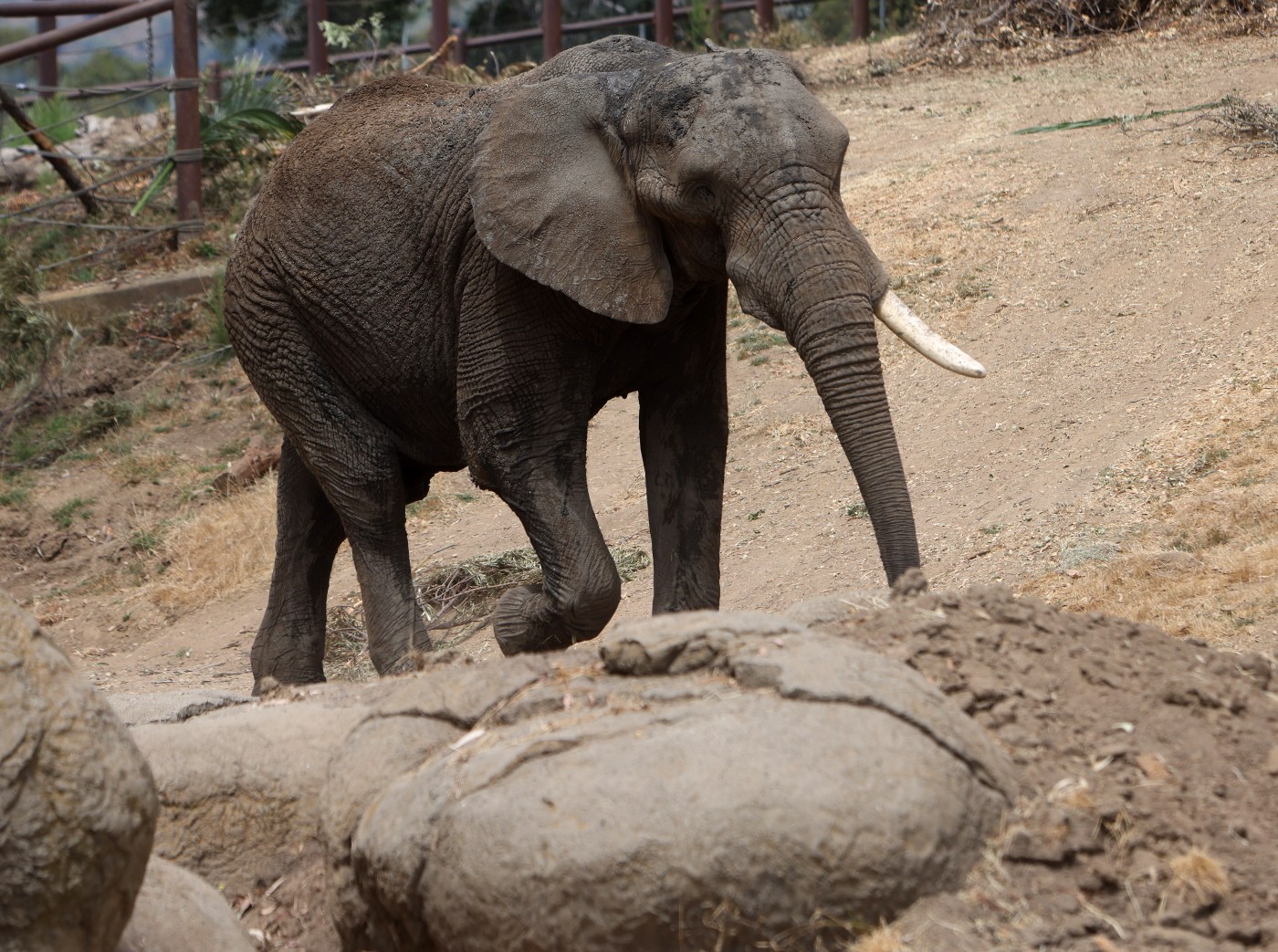Oakland lost the Raiders and the Warriors. The A’s are leaving this fall.
Next to go? The elephants.
But it’s not what you might think.
Osh, the lone elephant remaining from a once thriving group of four at the Oakland Zoo, will be departing before the end of the year.
The news has been particularly hard on the staff at the zoo, which had four elephants until 2019, when M’Dunda, 50, died unexpectedly. Lisa, 46, died in 2023, which made Donna, 44, the only female left in the group.
Females require more social interaction, so Donna was sent to The Elephant Sanctuary in Tennessee. The zoo kept Osh, a 30-year-old male, hoping to acquire a male companion for him, but attempts were unsuccessful. The Association of Zoos and Aquariums (AZA) accreditation standard for elephant exhibits is at least three female (or a mix of female and male elephants) or two male elephants.
There’s a happy ending, though: Osh will reunite with Donna at the sanctuary this fall.
“It’s really emotional for people; it’s emotional for me,” said Colleen Kinzley, vice president of animal care, conservation and research at the Oakland Zoo. “I’ve worked with elephants here for 35 years. And that’s my area of speciality.”
Elephants Osh (left) and Donna (right) interact through a fence line at the Oakland Zoo (Courtesy of the Oakland Zoo). The Oakland Zoo
Male elephants don’t always get along with females, but these two “had a good relationship,” she said.
The zoo has used the same habitat to house its elephants for 35 years, but research on elephant care has changed drastically over time.
There’s been a push to get elephants out of ancient zoo habitats, AZA president Dan Ashe said, and into larger spaces, where there are more opportunities to socialize and engage in natural behavior.
“With elephants, there’s a movement towards providing space and a staff that can manage a multigenerational herd,” Ashe said. “I applaud Oakland Zoo for the seriousness with which they’ve dealt with the situation with Osh and their other elephants. They’ve put a lot of thought into it.”
Kinzley has seen elephant care evolve significantly in her years at the Oakland Zoo, which was one of the first in America to champion a ban on bullhooks, a sharp hook used to inflict pain as a form of fear and discipline.
“We were one of the first zoos to utilize protected contact care, where you’re not going in with the elephants, you’re not using a bullhook, there’s no physical discipline,” Kinzley said. “All of our care for the elephants for the past 34 years has been through positive reinforcement.
“But that was a battle. I remember my first professional conference was hosted by Six Flags at Marine World. I was practically shouted off the podium. … We were villainized for that work. But we continued to be outspoken.”
Finally, in 2019, the AZA passed a ban on bullhooks. Elephants in U.S. zoos, at least, are now trained with positive reinforcement.
At the Tennessee sanctuary, many of the elephants were rescued from circuses and other entertainment industries. The 3,000-acre sanctuary is currently home to 12 elephants. Some have lived to 72 years of age; most make it into their 50s or 60s.
The Elephant Sanctuary near Hohenwald, Tenn. Osh, the lone elephant remaining from a once thriving group of four at the Oakland Zoo, will head for Tennessee to the nation’s largest elephant sanctuary this fall. (Michael Tercha /Chicago Tribune)
The herd size is expected to increase in the coming years as more zoos follow in Oakland’s footsteps.
“It’s a great trend,” said Ashley Dehnke, the sanctuary’s communications manager.
The Knoxville Zoo has closed its elephant exhibit and plans to send all its elephants to the sanctuary, Dehnke said. The Louisville Zoo will send two more elephants to the Sanctuary next year. And the Nashville Zoo sent all its elephants in 2015 and hasn’t reopened an elephant exhibit since.
The modern day zoo might not include elephants, but the future of zoos is bright, Ashe said.
“Zoos are saving animals from extinction,” he said. “Our hope is that people have an experience that connects them to nature and creates a sense of empathy for what’s happening to animals in nature, and a sense they can play a role in helping, that they made a contribution to conservation in nature, because they have.”
Meanwhile, Oakland Zoo and the sanctuary’s staff are working together to train new care staff and ensure a smooth transition. That includes several months of voluntary training for Osh before he begins his 40-hour journey, which includes stops for food, water and wellness checks, to Tennessee. His transport will be an air-conditioned trailer that can fit his 11-foot, 2-inch height and 15,000-pound weight.
Once he arrives at the sanctuary, Osh will begin his new life interacting with elephants through a fence, until he’s ready to begin socializing with contact.
“We let them adjust at their own pace,” Dehnke said. “Freedom of choice is a big thing. … Some elephants acclimate really quickly. Others take years. That’s OK.”
Donna, who arrived last September, struggled at first, but “every day she’s making good strides,” Dehnke said. “It’s really heartwarming to see. She’s starting to see how to navigate her environment. She’s a sweet elephant.”
Related Articles
Can anything be done about my cat that aims too high in the litter box?
Undercover staffers, burial pits and a five-ton mess: How Fremont scrambled to respond to 1,000 dead fish
What is the difference between pet insurance and wellness plans?
10 newborn puppies tossed out of car near California animal shelter are reunited with their mother
Meet Beacon the therapy dog, bringing joy from California to Team USA
Many of the elephants are coming from small spaces. Learning to move around the new terrain with its big hills and ponds takes adjustment.
Dehnke said she’s hopeful Donna will have a chance to reunite with Osh soon after he arrives. Although males and females don’t always interact, Donna and Osh have a positive history that provides hope for a reunion.
“Over time, if they start to feel more comfortable, we’ll let them share direct space,” Dehnke said.
Over the next few months, guests are encouraged to visit the Oakland Zoo to say goodbye to Osh and share favorite photos by sending them to web@oaklandzoo.org.
Visitors watch Osh the elephant at the Oakland Zoo on Sunday, Aug. 11, 2024, in Oakland, Calif. Osh, the lone elephant remaining from a once thriving group of four at the Oakland Zoo, will head for Tennessee to the nation’s largest elephant sanctuary this fall. (Aric Crabb/Bay Area News Group)
Visitors watch Osh the elephant at the Oakland Zoo on Sunday, Aug. 11, 2024, in Oakland, Calif. Osh, the lone elephant remaining from a once thriving group of four at the Oakland Zoo, will head for Tennessee to the nation’s largest elephant sanctuary this fall. (Aric Crabb/Bay Area News Group)
An elephant named Osh at the Oakland Zoo on Sunday, Aug. 11, 2024, in Oakland, Calif. Osh, the lone elephant remaining from a once thriving group of four at the Oakland Zoo, will head for Tennessee to the nation’s largest elephant sanctuary this fall. (Aric Crabb/Bay Area News Group)












